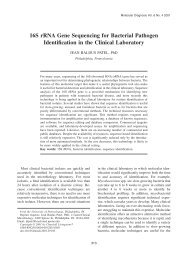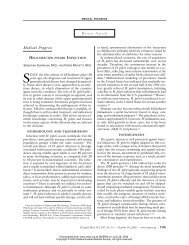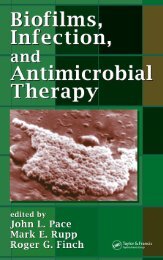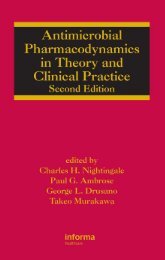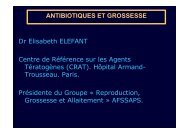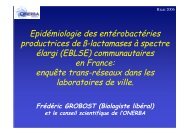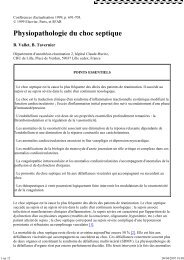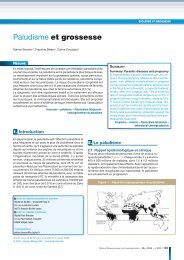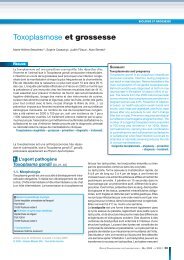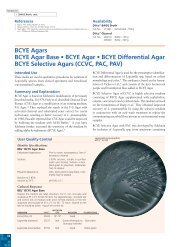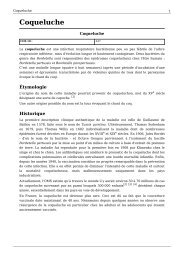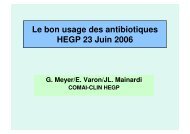Principles and Practice of Clinical Bacteriology Second Edition - Free
Principles and Practice of Clinical Bacteriology Second Edition - Free
Principles and Practice of Clinical Bacteriology Second Edition - Free
Create successful ePaper yourself
Turn your PDF publications into a flip-book with our unique Google optimized e-Paper software.
36 ORAL AND OTHER NON-β-HAEMOLYTIC STREPTOCOCCI<br />
isolates, 5 <strong>of</strong> which were found to be resistant to cefpirome <strong>and</strong> 12 to<br />
cefepime. How widespread this phenomenon <strong>of</strong> penicillin resistance<br />
was is difficult to ascertain, since a study from the opposite side <strong>of</strong> the<br />
Iberian Peninsula (Lugo), although admittedly based on a small<br />
collection <strong>of</strong> anginosus group bacteraemic strains (1988–1994), found<br />
all to be sensitive to penicillin <strong>and</strong> erythromycin (Casariego et al.,<br />
1996). More recent evidence from central Spain (Madrid) also<br />
reported a high proportion <strong>of</strong> non-β-haemolytic streptococci isolated<br />
from blood culture between 1998 <strong>and</strong> 2001 to be to erythromycin<br />
(42%), tetracycline (35%) <strong>and</strong> clindamycin (25%) resistant<br />
(Rodriguez-Avial et al., 2003). Researchers also found evidence <strong>of</strong><br />
cross-resistance between erythromycin <strong>and</strong> tetracycline, with resistance<br />
to one agent being associated with the occurrence <strong>of</strong> the other. Also <strong>of</strong><br />
note is that 3 <strong>of</strong> the 111 isolates tested by Rodriguez-Avial et al.<br />
(2003) were found to be resistant to the streptogramin quinupristin/<br />
dalfopristin.<br />
National surveillance data from Engl<strong>and</strong> <strong>and</strong> Wales also point to<br />
a similar increase in resistant phenotypes (PHLS, 2001, 2002; HPA,<br />
2003a). The numbers <strong>of</strong> bacteraemic strains reported through routine<br />
surveillance as having reduced susceptibility to penicillin increased<br />
between 2000 <strong>and</strong> 2002 for all non-β-haemolytic streptococcal<br />
groups, with yearly increases for S. mitis group being particularly<br />
pronounced, stepping from 9 reports in 2000 to 33 in 2001 to 73 in<br />
2003. Of the multitude <strong>of</strong> species that constitute the non-β-haemolytic<br />
streptococci, S. mitis, S. sanguis <strong>and</strong> S. oralis, have been described as<br />
most frequently exhibiting reduced susceptibility to penicillin<br />
(Alcaide et al., 1995; Mouton et al., 1997; de Azavedo et al., 1999;<br />
Wisplingh<strong>of</strong>f etal., 1999; Gershon etal., 2002). Analysis <strong>of</strong> streptococcal<br />
isolates submitted to the UK national reference laboratories between<br />
1996 <strong>and</strong> 2000, originating from patients with endocarditis, found one<br />
in four <strong>of</strong> S. mitis isolates to have reduced susceptibility to penicillin<br />
(MIC >0.125 mg/l), with one in seven <strong>of</strong> S. sanguis <strong>and</strong> one in eight<br />
<strong>of</strong> S. oralis isolates also showing reduced penicillin susceptibility<br />
(Johnson et al., 2001). Tetracycline <strong>and</strong> erythromycin resistance<br />
similarly increased over this period, with S. mitis group showing highest<br />
frequency <strong>of</strong> erythromycin resistance <strong>and</strong> S. bovis group showing the<br />
highest frequency <strong>of</strong> tetracycline resistance (HPA, 2003a). In the light<br />
<strong>of</strong> the common target <strong>of</strong> activity for streptogramins <strong>and</strong> macrolides,<br />
studies have found evidence <strong>of</strong> cross-resistance between erythromycin<br />
<strong>and</strong> quinupristin/dalfopristin (Mouton et al., 1997).<br />
Similarly worrying reports <strong>of</strong> antibiotic resistance in non-β-haemolytic<br />
streptococci causing bacteraemia <strong>and</strong>/or endocarditis emerged from<br />
other parts <strong>of</strong> Europe during this period. Although frequently based on<br />
small collections <strong>of</strong> strains, studies in France, Germany, Sweden <strong>and</strong><br />
Denmark documented substantial proportions <strong>of</strong> non-β-haemolytic<br />
streptococcal strains as having decreased sensitivity to erythromycin<br />
<strong>and</strong>/or penicillin (Wisplingh<strong>of</strong>f et al., 1999; Lefort et al., 2002; Westling<br />
et al., 2002). Pooled data for 1997–1998 from European countries<br />
participating in the SENTRY Antimicrobial Surveillance Programme<br />
found 39% <strong>of</strong> non-β-haemolytic streptococci to be nonsusceptible to<br />
penicillin, whereas 30% exhibited reduced susceptibility to erythromycin<br />
(Fluit et al., 2000).<br />
Interestingly, two studies from the Far East both showed high levels<br />
<strong>of</strong> macrolide resistance in bacteraemic isolates. Sixty-three per cent <strong>of</strong><br />
non-β-haemolytic streptococcal strains collection from Taiwan were<br />
reported as having reduced susceptibility to erythromycin <strong>and</strong><br />
clarithromycin, although all strains were sensitive to penicillin,<br />
cefotaxime, imipenem, vancomycin <strong>and</strong> teicoplanin (Teng et al.,<br />
2001). Similarly, in Hong Kong, characterization <strong>of</strong> bacteraemic<br />
S. bovis isolates showed all to be sensitive to penicillin, cephalothin<br />
<strong>and</strong> vancomycin, whereas 65% had reduced susceptibility to erythromycin.<br />
Forty-one per cent also showed reduced susceptibility to<br />
clindamycin (Lee et al., 2003). Subsequent reports from participants<br />
in the Asia-Pacific region SENTRY Antimicrobial Surveillance<br />
Programme, which includes Hong Kong <strong>and</strong> Taiwan, documented a<br />
frequency <strong>of</strong> penicillin <strong>and</strong> erythromycin resistance in non-β-haemolytic<br />
streptococci more akin to that documented in Europe <strong>and</strong> the Americas,<br />
possibly due to the effect <strong>of</strong> pooling data from many countries,<br />
including Australia <strong>and</strong> South Africa (Gordon et al., 2002).<br />
Research from North America began to show a similar pattern <strong>of</strong><br />
emerging penicillin resistance as that seen in Europe among nonβ-haemolytic<br />
streptococci. Studies conducted in the United States<br />
during the mid-1990s began to report levels <strong>of</strong> penicillin tolerance<br />
(nonsusceptibility) at between 39% <strong>and</strong> 44% <strong>of</strong> isolates (Doern et al.,<br />
1996; Pfaller et al., 1997). Cases <strong>of</strong> quinupristin/dalfopristin-resistant<br />
S. mitis have also been uncovered in the United States through the<br />
SENTRY Antimicrobial Surveillance Programme (Kugler et al., 2000).<br />
Similarly, research from the Canadian Bacterial Surveillance Network<br />
found levels <strong>of</strong> penicillin resistance increasing from the mid-1990s<br />
(28% <strong>of</strong> blood culture isolates) to 2000 (37%) (de Azavedo et al.,<br />
1999; Gershon et al., 2002). Bigger increases still were seen in the<br />
frequency <strong>of</strong> isolates nonsusceptible to erythromycin, from 29% to<br />
42%, with frequency <strong>of</strong> reduced clindamycin susceptibility also<br />
increasing from 4% to 10%.<br />
Following the mottled array <strong>of</strong> reports describing the emergence <strong>of</strong><br />
resistant phenotypes over 1990s, more recent descriptions from the<br />
SENTRY global antimicrobial surveillance network suggest that some<br />
degree <strong>of</strong> uniformity <strong>of</strong> antibiotic resistance may now exist among<br />
non-β-haemolytic streptococci causing blood stream infection<br />
(Gordon et al., 2002). The increase in resistance in these important<br />
pathogens presents a challenge to the treatment <strong>and</strong> control <strong>of</strong> infections<br />
<strong>and</strong> warrants further vigilance, especially in the light <strong>of</strong> the first<br />
description <strong>of</strong> a naturally occurring vancomycin-resistant S. bovis<br />
strain (Poyart et al., 1997).<br />
REFERENCES<br />
Ahmet, Z., Warren, M. <strong>and</strong> Huoang, E.T. (1995) Species identification <strong>of</strong><br />
members <strong>of</strong> the Streptococcus milleri group isolated from the vagina by ID<br />
32 Strep System <strong>and</strong> differential phenotypic characteristics. Journal <strong>of</strong><br />
<strong>Clinical</strong> Microbiology, 33, 1592–1595.<br />
Alcaide, F., Linares, J., Pallares, R. et al. (1995) In vitro activities <strong>of</strong> 22 beta-lactam<br />
antibiotics against penicillin-resistant <strong>and</strong> penicillin-susceptible viridans<br />
group streptococci isolated from blood. Antimicrobial Agents <strong>and</strong><br />
Chemotherapy, 39, 2243–2247.<br />
Alcaide, F., Carratala, J., Linares, J. et al. (1996) In vitro activities <strong>of</strong> eight<br />
macrolide antibiotics <strong>and</strong> RP-59500 (quinupristin-dalfopristin) against<br />
viridans group streptococci isolated from blood <strong>of</strong> neutropenic cancer<br />
patients. Antimicrobial Agents <strong>and</strong> Chemotherapy, 40, 2117–2120.<br />
Banks, J., Poole, S., Nair, S.P. et al. (2002) Streptococcus sanguis secretes<br />
CD14-binding proteins that stimulate cytokine synthesis: a clue to the<br />
pathogenesis <strong>of</strong> infective (bacterial) endocarditis Microbial Pathogenesis,<br />
32, 105–116.<br />
Barnard, J.P. <strong>and</strong> Stinson, M.W. (1996) The alpha-hemolysin <strong>of</strong> Streptococcus<br />
gordonii is hydrogen peroxide. Infection <strong>and</strong> Immunity, 64, 3853–3857.<br />
Barnard, J.P. <strong>and</strong> Stinson, M.W. (1999) Influence <strong>of</strong> environmental conditions<br />
on hydrogen peroxide formation by Streptococcus gordonii. Infection <strong>and</strong><br />
Immunity, 67, 6558–6564.<br />
Bayer, A.S., Ward, J.I., Ginzton, L.E. <strong>and</strong> Shapiro, S.M. (1994) Evaluation <strong>of</strong><br />
new clinical criteria for the diagnosis <strong>of</strong> infective endocarditis. The American<br />
Journal <strong>of</strong> Medicine, 96, 211–219.<br />
Bayer, A.S., Bolger, A.F., Taubert, K.A. et al. (1998) Diagnosis <strong>and</strong> management<br />
<strong>of</strong> infective endocarditis <strong>and</strong> its complications. Circulation, 98,<br />
2936–2948.<br />
Belko, J., Goldmann, D.A., Macone, A. <strong>and</strong> Zaidi, A.K. (2002) <strong>Clinical</strong>ly<br />
significant infections with organisms <strong>of</strong> the Streptococcus milleri group.<br />
The Pediatric Infectious Disease Journal, 21, 715–723.<br />
Bensing, B.A., Rubens, C.E. <strong>and</strong> Sullam, P.M. (2001) Genetic loci <strong>of</strong><br />
Streptococcus mitis that mediate binding to human platelets. Infection <strong>and</strong><br />
Immunity, 69, 1373–1380.<br />
Bensing, B.A., Siboo, I.R. <strong>and</strong> Sullam, P.M. (2001) Proteins PblA <strong>and</strong> PblB <strong>of</strong><br />
Streptococcus mitis, which promote binding to human platelets, are<br />
encoded within a lysogenic bacteriophage. Infection <strong>and</strong> Immunity, 69,<br />
6186–6192.<br />
Bentley, R.W., Leigh, J.A. <strong>and</strong> Collins, M.D. (1991) Intrageneric structure <strong>of</strong><br />
Streptococcus based on comparative analysis <strong>of</strong> small-subunit rRNA<br />
sequences. International Journal <strong>of</strong> Systematic <strong>Bacteriology</strong>, 41, 487–494.




